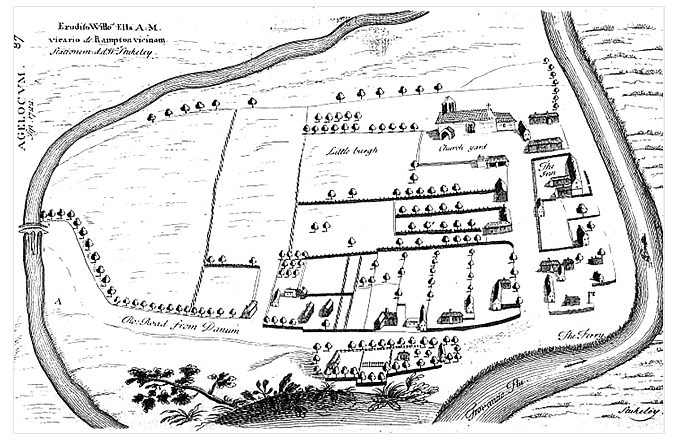Littleborough, Nottinghamshire on:
[Wikipedia]
[Google]
[Amazon]
Littleborough is a village and former
William Stukely's map of Littleborough
(1724) shows two possible arms of the Trent enclosing the Roman town of Segelocum (or Agelocum). This might explain why the Roman fort at Manton now lies across the river rather than close to the hamlet.
reconstruction of Roman Segelocum
Villages in Nottinghamshire Former civil parishes in Nottinghamshire Bassetlaw District {{Nottinghamshire-geo-stub
civil parish
In England, a civil parish is a type of administrative parish used for local government. It is a territorial designation which is the lowest tier of local government. Civil parishes can trace their origin to the ancient system of parishes, w ...
, now in the parish of Sturton le Steeple
Sturton le Steeple is a village located east of Retford, Nottinghamshire, England. According to the 2001 census it had a population (including Littleborough and Fenton) of 497, reducing slightly to 486 at the 2011 census, but increasing to ...
, in the Bassetlaw district, in the county of Nottinghamshire
Nottinghamshire (; abbreviated ''Notts.'') is a ceremonial county in the East Midlands of England. The county is bordered by South Yorkshire to the north-west, Lincolnshire to the east, Leicestershire to the south, and Derbyshire to the west. Th ...
, England. It is east of Retford
Retford (), also known as East Retford, is a market town in the Bassetlaw District in Nottinghamshire, England. It lies on the River Idle and the Chesterfield Canal. Retford is located east of Sheffield, west of Lincoln, Lincolnshire, Linco ...
. Littleborough is the site of the Roman
Roman or Romans most often refers to:
*Rome, the capital city of Italy
*Ancient Rome, Roman civilization from 8th century BC to 5th century AD
*Roman people, the people of Roman civilization
*Epistle to the Romans, shortened to Romans, a letter w ...
town of Segelocum or Agelocum, on the west bank of the River Trent
The Trent is the third Longest rivers of the United Kingdom, longest river in the United Kingdom. Its Source (river or stream), source is in Staffordshire, on the southern edge of Biddulph Moor. It flows through and drains the North Midlands ...
where the road linking Lincoln
Lincoln most commonly refers to:
* Abraham Lincoln (1809–1865), the 16th president of the United States
* Lincoln, England, cathedral city and county town of Lincolnshire, England
* Lincoln, Nebraska, the capital of Nebraska, U.S.
* Lincoln (na ...
and Doncaster
Doncaster ( ) is a city status in the United Kingdom, city in South Yorkshire, England. Named after the River Don, Yorkshire, River Don, it is the administrative centre of the City of Doncaster metropolitan borough, and is the second largest se ...
bridged or forded the river. In 1931 the parish had a population of 32. On 1 April 1935 the parish was abolished and merged with Sturton le Steeple.
The Church of England parish church of St Nicholas is Norman
Norman or Normans may refer to:
Ethnic and cultural identity
* The Normans, a people partly descended from Norse Vikings who settled in the territory of Normandy in France in the 9th and 10th centuries
** People or things connected with the Norma ...
, and contains some Roman tiles in its stonework.
Littleborough Ferry
A ferry existed here for centuries. In 1825 a toll road from Retford to Littleborough and on to Lincoln was opened. Due to competition from Dunham, in 1830 the turnpike trust engaged Mr Timothy Bramah (son of Joseph Bramah) to design a bridge. However in 1832 Dunham bridge opened but there was no progress at Littleborough. In 1912-1913 new plans to build a bridge on site of ‘old Roman ford’ and undercut Gainsborough toll bridge were proposed but never proceeded. Despite this in 1897 there were complaints that the ferry had been ‘stopped’ on the orders of the landowner, Mr Foljambe. Only a small foot boat was available – the defence being that a ferry 'did not pay'. In 1898 it had a new boat but this was too small to take horse and trap. Previously there was a cart ferry – and also a foot ferry. In 1900 Foljambe sued the Trent Navigation after their boat damaged the ferry. It had been drifting in a flood, cutting the chain across the Trent and capsizing the ferry. The defence argued that the ferry had not been used for months and possibly had a hole in it. The Judge ruled for the Navigation. In 1905 Foljambe said he would abandon it and no council was prepared to pay for a legal challenge.Nottingham Journal, 2 August 1905 Nottinghamshire County Council had no powers to operate a ferry. Thus in 1912 there were new calls for a bridge. The 1920 Ferries (Acquisition by local authorities) Act made it possible for councils to run a ferry but the local councils refused anything for Littleborough. In 1920 the cost of a new ferry and landing stages was estimated at £3000.William Stukely's map of Littleborough
(1724) shows two possible arms of the Trent enclosing the Roman town of Segelocum (or Agelocum). This might explain why the Roman fort at Manton now lies across the river rather than close to the hamlet.

See also
* Listed buildings in Sturton le SteepleReferences
External links
reconstruction of Roman Segelocum
Villages in Nottinghamshire Former civil parishes in Nottinghamshire Bassetlaw District {{Nottinghamshire-geo-stub